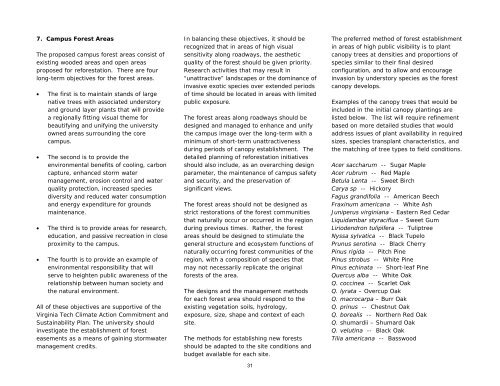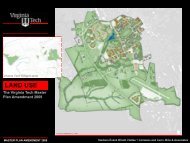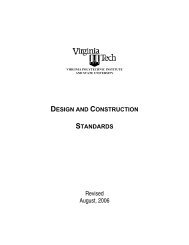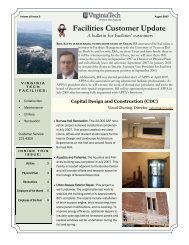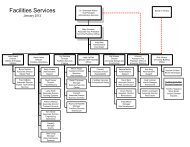Campus Design Principles - Facilities Services - Virginia Tech
Campus Design Principles - Facilities Services - Virginia Tech
Campus Design Principles - Facilities Services - Virginia Tech
You also want an ePaper? Increase the reach of your titles
YUMPU automatically turns print PDFs into web optimized ePapers that Google loves.
7. <strong>Campus</strong> Forest Areas In balancing these objectives, it should be<br />
recognized that in areas of high visual<br />
The proposed campus forest areas consist of sensitivity along roadways, the aesthetic<br />
existing wooded areas and open areas<br />
quality of the forest should be given priority.<br />
proposed for reforestation. There are four Research activities that may result in<br />
long-term objectives for the forest areas.<br />
“unattractive” landscapes or the dominance of<br />
invasive exotic species over extended periods<br />
of time should be located in areas with limited<br />
public exposure.<br />
• The first is to maintain stands of large<br />
native trees with associated understory<br />
and ground layer plants that will provide<br />
a regionally fitting visual theme for<br />
beautifying and unifying the university<br />
owned areas surrounding the core<br />
campus.<br />
• The second is to provide the<br />
environmental benefits of cooling, carbon<br />
capture, enhanced storm water<br />
management, erosion control and water<br />
quality protection, increased species<br />
diversity and reduced water consumption<br />
and energy expenditure for grounds<br />
maintenance.<br />
• The third is to provide areas for research,<br />
education, and passive recreation in close<br />
proximity to the campus.<br />
• The fourth is to provide an example of<br />
environmental responsibility that will<br />
serve to heighten public awareness of the<br />
relationship between human society and<br />
the natural environment.<br />
All of these objectives are supportive of the<br />
<strong>Virginia</strong> <strong>Tech</strong> Climate Action Commitment and<br />
Sustainability Plan. The university should<br />
investigate the establishment of forest<br />
easements as a means of gaining stormwater<br />
management credits.<br />
The forest areas along roadways should be<br />
designed and managed to enhance and unify<br />
the campus image over the long-term with a<br />
minimum of short-term unattractiveness<br />
during periods of canopy establishment. The<br />
detailed planning of reforestation initiatives<br />
should also include, as an overarching design<br />
parameter, the maintenance of campus safety<br />
and security, and the preservation of<br />
significant views.<br />
The forest areas should not be designed as<br />
strict restorations of the forest communities<br />
that naturally occur or occurred in the region<br />
during previous times. Rather, the forest<br />
areas should be designed to stimulate the<br />
general structure and ecosystem functions of<br />
naturally occurring forest communities of the<br />
region, with a composition of species that<br />
may not necessarily replicate the original<br />
forests of the area.<br />
The designs and the management methods<br />
for each forest area should respond to the<br />
existing vegetation soils, hydrology,<br />
exposure, size, shape and context of each<br />
site.<br />
The methods for establishing new forests<br />
should be adapted to the site conditions and<br />
budget available for each site.<br />
The preferred method of forest establishment<br />
in areas of high public visibility is to plant<br />
canopy trees at densities and proportions of<br />
species similar to their final desired<br />
configuration, and to allow and encourage<br />
invasion by understory species as the forest<br />
canopy develops.<br />
Examples of the canopy trees that would be<br />
included in the initial canopy plantings are<br />
listed below. The list will require refinement<br />
based on more detailed studies that would<br />
address issues of plant availability in required<br />
sizes, species transplant characteristics, and<br />
the matching of tree types to field conditions.<br />
Acer saccharum -- Sugar Maple<br />
Acer rubrum -- Red Maple<br />
Betula Lenta -- Sweet Birch<br />
Carya sp -- Hickory<br />
Fagus grandifolia -- American Beech<br />
Fraxinum americana -- White Ash<br />
Juniperus virginiana – Eastern Red Cedar<br />
Liquidambar styraciflua – Sweet Gum<br />
Liriodendron tulipifera -- Tuliptree<br />
Nyssa sylvatica -- Black Tupelo<br />
Prunus serotina -- Black Cherry<br />
Pinus rigida -- Pitch Pine<br />
Pinus strobus -- White Pine<br />
Pinus echinata -- Short-leaf Pine<br />
Quercus alba -- White Oak<br />
Q. coccinea -- Scarlet Oak<br />
Q. lyrata – Overcup Oak<br />
Q. macrocarpa – Burr Oak<br />
Q. prinus -- Chestnut Oak<br />
Q. borealis -- Northern Red Oak<br />
Q. shumardii – Shumard Oak<br />
Q. velutina -- Black Oak<br />
Tilia americana -- Basswood<br />
31


